Surabaya (or in the old days, Soeribaea)
We are in Surabaya, 420 miles east of Jakarta, and 7 degrees south of the equator. The capital of East Java, it’s a city of about 3-4 million, on the Java Sea, with some intriguing mountains in the distance. It took us most of the day to get here yesterday, which is probably the first lesson today about Indonesia; it is hard to get around not just the 17,000 islands spread over 3,000 miles—sometimes it’s hard to get around one of the islands, in this case, Java, the most populous. My understanding is that there is not a highway across the island.
We had a nice mix of activities today, which began with a visit to the 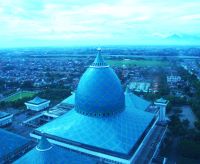 National Mosque of Surabaya, a huge building with a blue and green dome that dominates the city. As I’ve stressed, Indonesia has a Muslim
National Mosque of Surabaya, a huge building with a blue and green dome that dominates the city. As I’ve stressed, Indonesia has a Muslim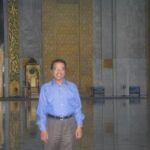 majority, but everyone emphasizes it’s a secular democracy. However, even in the airport, we saw many more Muslims dressed in the traditional robes than we had seen in Jakarta.
majority, but everyone emphasizes it’s a secular democracy. However, even in the airport, we saw many more Muslims dressed in the traditional robes than we had seen in Jakarta.
Our second visit was to one of the tourist-listed places (it says something that of the six places listed in the brochures for tours, two are malls, and one is a national park)—the Hotel Majahapit. The historic hotel (you knew there was a reason it was special for me!) was built by the Sarkie Brothers,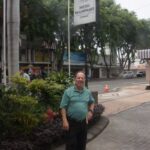 who brought luxury to SE Asia from the 1890s into the 20th century. I’ve stayed in several—the Raffles in Singapore (home to the Singapore Sling), the Eastern and Oriental in Penang, and two in Cambodia—and had dinner at their hotel—the Strand—in Rangoon. The Majahapit (born in 1910 as the
who brought luxury to SE Asia from the 1890s into the 20th century. I’ve stayed in several—the Raffles in Singapore (home to the Singapore Sling), the Eastern and Oriental in Penang, and two in Cambodia—and had dinner at their hotel—the Strand—in Rangoon. The Majahapit (born in 1910 as the 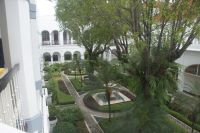 Oranje) well lived up to the brand name. The older part of the hotel is Colonial, the newer part (dating from the 1930s, and opened by Charlie Chaplin) is art deco. We got to see a number of rooms (one of which had a “crapper”; for those who don’t know it, John Crapper invented a toilet, with a tank that sat up high and a pull chain to flush), including the one occupied by the Dutch High Command in 1945 in the face of Indonesian efforts to declare independence
Oranje) well lived up to the brand name. The older part of the hotel is Colonial, the newer part (dating from the 1930s, and opened by Charlie Chaplin) is art deco. We got to see a number of rooms (one of which had a “crapper”; for those who don’t know it, John Crapper invented a toilet, with a tank that sat up high and a pull chain to flush), including the one occupied by the Dutch High Command in 1945 in the face of Indonesian efforts to declare independence
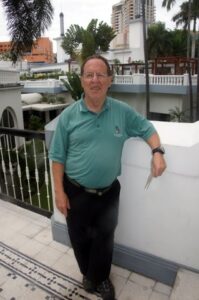
from Holland. An angry local mob stormed the hotel’s flagpole and tore off the blue on the bottom of the Dutch flag, leaving only the Red-and-White, which remains the flag of the Republic of Indonesia. Not coincidentally, the Scout neckerchief is red and white today, partly because the Scouts played an active role in the war for Independence.
The business visit this afternoon was arranged by UPH, the Lippo group university I mentioned we had visited in Jakarta. It has a newer, smaller (600-student) campus in Surabaya, targeting a similar market segment—mostly wealthy Chinese. I think I mentioned that the Lippo group is building housing units centered around schools and hospitals (which it builds into the community). The University in Jakarta has a medical school, which helps the group get a lead on physicians.
The company we visited works for chicken feed—rather works with chicken feed, and chickens. It is the main supplier of ayam (chicken) for KFC and McDonalds, and is overall the third largest chicken processor in Indonesia. From what the Chief Financial Officer told us, the company is operating close to capacity, which means it’s not exporting (and, to my surprise, said chicken prices in the U.S. are less than in Indonesia), but because the consumption rate in Indonesia is 4.8 kg a year, much lower than elsewhere in Southeast Asia, the executives expect they can continue to grow domestically for a long time. I learned a lot about chickens—given my Chicago upbringing, it was almost a surprise to learn that chickens do not grow prepackaged. Instead, the company buys “grandfather generations” from the U.S. and France, hatches them out for 6 months, gets a second “parent” generation for six months, then takes the third generation (“one-day chicks”) for 32 days of scientific feeding until the chickens weigh 1.8 kilograms. The company manufactures chicken feed, harvests (their words) broilers and roasters, processes (slaughters) and sells them to, as I said, McDonalds and KFC, or at retail, under the brand name “Gold Star” to Carrefour and other retailers in Indonesia. They served us enough samples after our session that we might have upped the average to 4.9 kilograms.
I was just thinking it would be nice to observe the stars in the southern hemisphere. Unfortunately, this is the hot and rainy season, and we’ve barely seen the sun, much less the stars. The other season, though (April-October) is hot and humid. In other words, the temperature now is roughly 88 degrees with a 30% chance of rain—everyday.
Good Content excellent resource for anyone looking to learn more about this topic. It’s well-researched, well-written, and very informative! Dunia Usaha